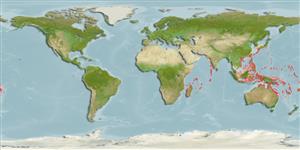>
Blenniiformes (Blennies) >
Tripterygiidae (Triplefin blennies) > Tripterygiinae
Etymology: Helcogramma: Greek, helkos, -eos, -ous = ulcer, sore + Greek, gramma = letter, mark (Ref. 45335).
Environment: milieu / climate zone / depth range / distribution range
Écologie
marin récifal; profondeur 0 - 10 m (Ref. 6211). Tropical
Indo-West Pacific: South Africa and Arabia to Taiwan and New Guinea.
Taille / Poids / Âge
Maturity: Lm ? range ? - ? cm
Max length : 3.8 cm SL mâle / non sexé; (Ref. 75031)
Description synthétique
Clés d'identification | Morphologie | Morphométrie
Épines dorsales (Total) : 16 - 18; Rayons mous dorsaux (Total) : 10 - 12; Épines anales: 1; Rayons mous anaux: 19 - 21; Vertèbres: 36 - 38. Diagnosis: Dorsal fin III + XIV+ 11, 1st fin 4/5 height of 2nd fin, 1 free pterygiophore between 2nd and 3rd fin; anal fin I + 21; pectoral rays 17 (1+9+7); pelvic fin I, 2, spine short and hidden, segmented rays simple, partially united by membrane. Vertebrae 10 + 27. LL total lateral scales 39-40; tubed 22-30 scales, ends below anterior half of 3rd dorsal fin; nape, 1st and 2nd dorsal fin and anal-fin base scaleless, caudal fin base with 1 row of scales. Mandibular pores 5-8+1-2+5-8. Orbital cirrus simple. Head length 3.4 in SL; eye 2.9, maxilla 2.1 in HL. Male head with blue stripe below eye from mouth to pectoral-fin base and masked with black on ventral half; body pinkish orange with scattered dusky rosettes denser ventrally; larger ones with 5-6 light grey blotches and dusky triangular marks; median fins generally uniformly dark to black. Female paler version of male but not masked (Ref. 75031).
Adults live on rock surfaces and under ledges; common at depths less than 10 m (Ref. 6211). Eggs are hemispherical and covered with numerous sticky threads that anchor them in the algae on the nesting sites (Ref. 240). Larvae are planktonic which occur primarily in shallow, nearshore waters (Ref. 94114).
Life cycle and mating behavior
Maturities | Reproduction | Spawnings | Egg(s) | Fecundities | Larves
Hansen, P.E.H., 1986. Revision of the tripterygiid fish genus Helcogramma, including descriptions of four new species. Bull. Mar. Sci. 38(2):313-354. (Ref. 6211)
Statut dans la liste rouge de l'IUCN (Ref. 130435)
Menace pour l'homme
Harmless
Utilisations par l'homme
Outils
Articles particuliers
Télécharger en XML
Sources Internet
Estimates based on models
Preferred temperature (Ref.
123201): 24.7 - 29.3, mean 28 °C (based on 1759 cells).
Phylogenetic diversity index (Ref.
82804): PD
50 = 0.5000 [Uniqueness, from 0.5 = low to 2.0 = high].
Bayesian length-weight: a=0.00562 (0.00258 - 0.01228), b=3.08 (2.89 - 3.27), in cm total length, based on LWR estimates for this (Sub)family-body shape (Ref.
93245).
Niveau trophique (Ref.
69278): 3.1 ±0.3 se; based on size and trophs of closest relatives
Résilience (Ref.
120179): Haut, temps minimum de doublement de population inférieur à 15 mois (Preliminary K or Fecundity.).
Fishing Vulnerability (Ref.
59153): Low vulnerability (10 of 100).
Nutrients (Ref.
124155): Calcium = 462 [187, 1,675] mg/100g; Iron = 2.48 [0.96, 5.42] mg/100g; Protein = 18 [16, 20] %; Omega3 = 0.0928 [, ] g/100g; Selenium = 48.8 [10.8, 192.0] μg/100g; VitaminA = 73.9 [13.0, 457.5] μg/100g; Zinc = 4.84 [2.25, 8.83] mg/100g (wet weight);
